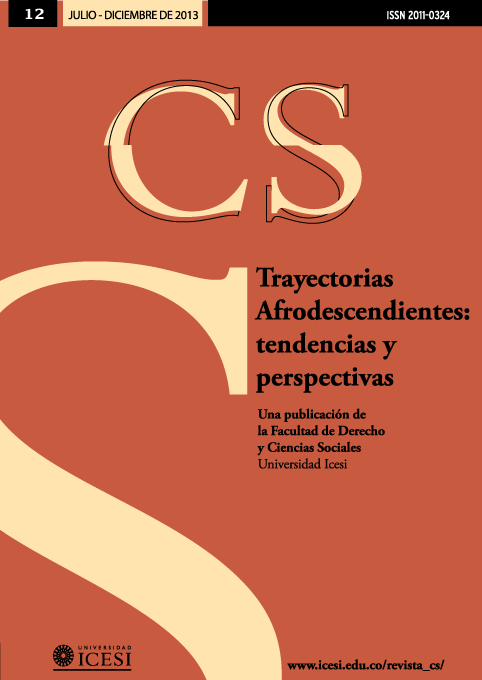Mobilitiy and Resistance of the Black Caribs: The Past and Present of the Garifuna
DOI:
https://doi.org/10.18046/recs.i12.1681Keywords:
Garifunas, Identities, Transnationality, Mobilization, PoliticsAbstract
The black Caribs, or Garifuna, have populated the Caribbean coasts of four Central American countries (Belize, Guatemala, Honduras and Nicaragua) since the end of the eighteenth century. Through a continual process of migration begun in the mid–twentieth century, much of its population currently lives in the United States. The transnationality of the original establishment of their community in Central America and that of their more recent presence in the U.S. have always been accompanied by a rich flow of identity symbols. These symbols articulate diverse ethno–racial representations that have transformed due to the impact of national, global and regional political and social processes to the point of becoming generically identified as a part of the larger Afro–descendent community. This article aims to present, from a historical perspective, the dynamics of the construction of Garifuna identities, the actors involved in these processes and their political dynamics.
Downloads
References
Agudelo, C. (2010). Génesis de redes transnacionales de movimientos afrolatinoamericanos. Su presencia en América Central. En O. Hoffmann (Ed.), Ciudadanía y Política entre los afrodescendientes en México y América central. México: CEMCA–INAH–IRD–UNAM.
Agudelo, C. (2012). Qu'est–ce qui vient après la reconnaissance? Multiculturalisme et populations noires en Amérique latine. En C. Gros y D. Dumoulin Kervran (Eds.), Le multiculturalisme au concret. Un modèle latino américain?. París, Francia: Presses Sorbonne Nouvelle.
Agudelo, C (2009). Comunicación: 'El día nacional garífuna en Guatemala: de fiesta local a instrumentalización nacional/global' 53° Congreso Internacional de Americanistas. Los pueblos americanos: cambios y continuidades. La construcción de lo propio en un mundo globalizado. Simposio: Expresiones culturales y dinámicas identitarias desde el Caribe contemporáneo. Ciudad de México, 19 al 24 de julio de 2009.
Amaya, J. (2004). ''Reimaginando' la nación en Honduras: de la 'nación homogénea' a la 'nación pluriétnica'. Los negros garífunas de Cristales, Trujillo', Tesis doctoral en Estudios Latinoamericanos, Universidad Complutense de Madrid.
Amaya, J. (2007). Las imágenes de los Negros Garífunas en la Literatura Hondureña y Extranjera. Tegucigalpa, Honduras: Cultura.
Anderson, M. (2007). When Afro Becomes (like) Indigenous: Garífuna and Afro–Indigenous Politics. The Journal of Latin American and Caribbean Anthropology, 12 (2), 384–413.
Anderson, M. (2008). Garinagu Hondureña y los significados de 'Negro' en los 1930s y 1940s. Ponencia Congreso Diáspora, Nación y Diferencia, 10 al 13 de junio, Veracruz, México.
Anderson, M. y England, S. (2005). Auténtica cultura africana en Honduras? Los afrocentroamericanos desafían el mestizaje indohispano en Honduras. En D. Euraque et al. (Eds.), Memorias del Mestizaje. Cultura política en Centroamérica de 1920 al presente (pp. 253–294). Guatemala: CIRMA.
Arrivillaga Cortés, A. (1985). Etnografía de la fiesta de San Isidro Labrador. Livingston, Izabal, Guatemala. La tradición popular, 54, 1–16.
Arrivillaga, A. (2005). Marcos Sanchez Diaz from hero to hiuraha– two hundred years of Garífuna settlement in Central America. En J. Palacio, The Garífuna: A Nation across Borders. Essays in Social Anthropology (pp. 64–84). Belice: Cubola Press.
Arrivillaga Cortés, A. (2006). Marcos Sánchez Díaz fundador y protector de gulfuiyumu.Guatemala: Comisión Presidencial contra la discriminación y el racismo.
Arrivillaga Cortés, A. (2009). La población garífuna migrante. Guatemala: CODISRA.
Beaucage, P. (1970). 'Economic Anthropology of the Black Carib of Honduras', Tesis de doctorado, University of London.
Breton, R., Besada P., Bernabé J. (1665). Dictionnaire caraïbe – français. Paris, Francia: KARTHALA.
Burton, R. (1685). The English Empire in America. Londres, Inglaterra: Nathaniel Crouch.
Cáceres, R. (Ed). (2008). Tomo 1: Del olvido a la memoria: Africanos y afromestizos en la historia colonial de Centroamérica. San José: UNESCO.
Cayetano, M. y Cayetano, R. (2005). Garífuna language, dance, and music – a masterpiece of oral and intangible heritage of humanity. How did it happen?. En J. Palacio, The Garífuna: A Nation across Borders. Essays in Social Anthropology (pp. 230–249). Belice: Cubola Press.
Cayetano, S. (1996). Garífuna History, Language and Cultura of Belize Central America and the Caribbean. Belice: Angelus Press.
Cohelo, R. (1995). Los Caribes Negros de Honduras. Tegucigalpa, Honduras: Guaymuras.
Conzemius, E. (1928). Ethnographic Notes on the Black Carib (Garif). American Anthropologist, 30, 183–205.
Cuisset O. (2009). Tourisme et Garífunas à Livingston, Guatemala. Economie et culture en contexte touristique. Documento de Trabajo No. 7. México: Proyecto AFRODESC. Disponible en: http://www.ird.fr/afrodesc/IMG/pdf/Cuaderno7–Cuisset–3.pdf.
Davidson, W. (1974). The Caribs (Garífuna) of Central America. A map or their realm and Bibliography or research. Belizean Studies, 2 (4).
Davidson, W. (1979). Dispersal of the Garífuna in the Western Caribbean. Actes of the Forty–Second Internacional Congreso of Americanists, 6, 467–474.
Davidson, W. (1980). The Garífuna of Pearl Lagoon: Ethnohistory of an afro–american enclave in Nicaragua. Ethnohistory, 1 (27).
Du Tertre, J. B. (1671). Histoire Générale des Antilles habitées par les François 1635– 1671. París, Francia.
Euraque, D. (2004). Conversaciones históricas con el mestizaje y su identidad nacional en Honduras. Honduras: Centroeditorial.
Euraque, D. et al. (Ed). (2005). Memorias del Mestizaje. Cultura política en Centroamérica de 1920 al presente. Guatemala: CIRMA.
Frühling, P., González, M. y Peter–Buvollen, H. (2007). Etnicidad y nación. El desarrollo de la autonomía de la Costa Atlántica de Nicaragua. 1987–2007. Guatemala: F&G Editores.
Gargallo, F. (2000). Los Garífuna de Centroamérica: reubicación, sobrevivencia y nacionalidad de un pueblo afroindoamericano. Política y Cultura, 14, 89–107.
Gargallo, F. (2002). Garífuna Garínagu, Caribe. México: Siglo XXI.
González, N. (1976). From Black Carib to Garífuna: The coming of Age of an Ethnic Group, en Actes of the Forty–Second International Congress of Americanists, 6, pp. 577–588
González, N. (1988). Peregrinos del Caribe. Etnogénesis y etnohistoria de los garífunas. Tegucigalpa, Honduras: Editoria Guaymuras.
González, N. (1988a). Sojourners of the Caribbean: Ethnogenesis and Ethnohistory of the Garífuna.Estados Unidos: University of Illinois Press.
Gudmundson, L. (2009). Africanos y afrodescendientes en Centroamérica. Nuevo Mundo Mundos Nuevos, Debates. Disponible en http://nuevomundo.revues.org/index57996.html.
Gullick, C. (1976). Exiled from St. Vincent: The Development of Black Caribe Culture in Central America Up to 1945. Malta: Malta Progress Press.
Houdaille, J. (1954). Negros Franceses en América Central a fines del siglo XVIII. Antropología e Historia de Guatemala, 6 (1), 65–67.
Izard, G. (2003). La construcción política de la identidad garífuna en el Belice contemporáneo. Revista de las Américas. Historia y presente, (1).
Labat, J. (1970). The memoirs of Pere Labat, 1693–1705. Londres, Inglaterra: Frank Cass.
Labat, J. (1979). Voyage aux Iles de l'Amérique (Antilles), 1693–1705. París, Francia: Seghers.
Lizcano, F. (1993). La Población Negra en el Istmo Centroamericano. En L. M. Martínez Montiel (Coord.), Presencia Africana en Centroamérica. México: CONACULTA.
López García, V. (1994). La Bahía de Puerto del Sol y la Masacre de los Garífunas de San Juan. Tegucigalpa, Honduras: Guaymuras.
Meléndez, A. C. (1997). El enojo de las sonajas. Palabras del Ancestro. Tegucigalpa, Honduras: Graficentro.
Mintz, S. y Price, R. (1992). The Birth of American Culture. An Anthropological Perspective. Boston, Estados Unidos: Bacon Press.
Mohr De Collado, M. (2007). Los garinagu en Centroamérica y otros lugares. Identidades de una población afro–caribe entre la tradición y la modernidad. INDIANA, 24.
ODECO, (2008). 211 años de presencia Garífuna en Centroamérica.
Palacio, J. (2005). Reconstructing Garífuna oral history – techniques and methods in the history of a Caribbean people. En J. Palacio, The Garífuna: A Nation across Borders. Essays in Social Anthropology (pp. 43–63). Belice: Cubola Press.
Palacio, J. (2005a). The multifaceted Garífuna: juggling cultural spaces in the 21 st century. En J. Palacio (Coord), The Garífuna a nation across borders. Essays in Social Anthropology pp. 105–122). Belice: Cubola.
Rey, N. (2005). Quand la révolution, aux Amériques, était nègre... Caraïbes nöirs, negros franceses et autres '' oubliés '' de l'Histoire. París, Francia: Karthala.
Taylor, D. (1951). The Black Caribs of British Honduras. Viking Fund Publications in Anthropology, (17).
Taylor, D. (1958). Carib, Caliban, Cannibal. International Journal of American Linguistics, 24, 156–157.
Victoria, J. (s.f.). Los negros auxiliares de España en Centroamérica. Boletín AFEHC, (21). Recuperado el 4 de abril de 2006 de: http://afehc–historiacentroamericana.org/375.
Wade, P. (2000). Raza y etnicidad en Latinoamérica. Quito, Ecuador: Abya–Yala.
Young, W. (1975). An account of the Black Charaibs in the Island of St. Vincent. Londres, Inglaterra: Frank Cass.
Downloads
Published
Issue
Section
License
Copyright (c) 2013 Carlos Agudelo

This work is licensed under a Creative Commons Attribution-NonCommercial 4.0 International License.
© Reserved Copyright
Material in this publication may be reproduced without authorization, provided the title, author and institutional source is acknowledged.
The content published in Revista CS is distributed under the Creative Commons BY-NC 4.0 Attribution/Recognition-NonCommercial 4.0 International license.
You are free to:
Share — copy and redistribute the material in any medium or format.
Adapt — remix, transform, and build upon the material.
Under the following terms:
Attribution — You must give appropriate credit , provide a link to the license, and indicate if changes were made . You may do so in any reasonable manner, but not in any way that suggests the licensor endorses you or your use.
NonCommercial — You may not use the material for commercial purposes.












